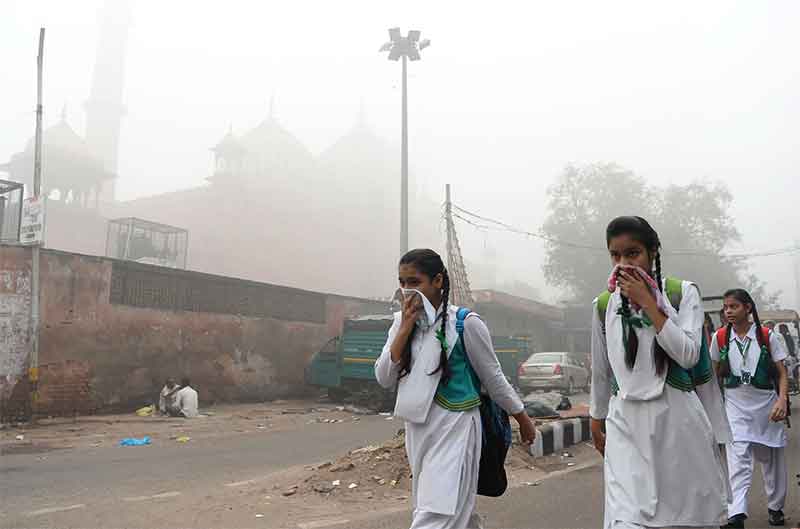
The world today is heating up at an alarming pace. Climate change, together with rising levels of air pollution, has brought humanity to the brink of a crisis unlike anything seen before. Weather cycles that were once predictable are now dangerously disrupted, while sudden climatic shocks devastating storms, floods, and fires strike with increasing frequency. The Earth, which has always been a secure home for plants, animals, and human civilization, is slowly turning into a place of uncertainty and fear.
Events that were once so rare that they occurred perhaps once in a century are now becoming disturbingly routine. Recently, Typhoon Wefa in southern China swept through with such violence that people were seen being lifted into the air as they struggled to walk. Uttarakhand witnessed a catastrophic flood triggered by a cloudburst that tore entire mountains apart, burying villages under its fury. In Russia’s far east, the Kroshennikov volcano erupted after 600 years, sending ash plumes soaring four kilometers into the sky. These are not isolated incidents but part of a frightening pattern: climate change has turned the extraordinary into the ordinary.
Scientists call this paradoxical reality a climate oxymoron — a world where opposites exist side by side, where severe droughts grip one region while catastrophic floods submerge another, where wildfires rage uncontrollably while glaciers melt at record speed. Earthquakes of unimaginable magnitude, once noted only in distant historical records, now find mention in our daily news. Hurricanes, previously rare in their intensity, now strike with three times the frequency recorded a century ago. In the Mississippi Valley, torrential rains last April were so extreme that they were expected statistically only once in 500 years. The world has entered a phase where disasters that once defined eras now define seasons.
The science behind this chaos is straightforward but alarming. The atmosphere is growing hotter and drier, yet paradoxically capable of holding far more moisture. This accelerates the water cycle, so that when it rains, it pours with unrelenting intensity, and when it dries, it scorches with merciless drought. Scientists warn that the Earth, already 1.5°C warmer than pre-industrial levels in 2024, is on track to reach a rise of 2°C by 2030. Such a shift would push us into uncharted territory, with consequences that may be irreversible for both humanity and the natural world.
Adding to this climate emergency is another invisible killer: air pollution. Though less dramatic than a hurricane or flood, it is no less destructive. It seeps silently into the lungs of millions, contaminates soils and waters, and destabilizes delicate ecosystems. India today stands at the epicenter of this crisis. Cities such as Delhi, Mumbai, Kolkata, Bengaluru, and Chennai rank among the most polluted in the world. Industrial smoke filled with sulfur and nitrogen compounds hangs heavily over urban skylines. Construction dust fills the air with choking particles. Waste is openly burned on city streets, releasing deadly toxins from plastics and rubber. And millions of vehicles on congested roads belch carbon monoxide and nitrogen oxides into the air each day.
The consequences are devastating. Respiratory illnesses such as asthma, bronchitis, and lung cancer are on the rise, particularly among children and the elderly. Long-term exposure to toxic air increases the risks of heart disease and stroke. Acid rain eats away at the fertility of soils, poisons rivers and lakes, and drives ecosystems toward collapse. Even the economy bears the burden, with rising healthcare costs, falling worker productivity, and an overall decline in the quality of urban life. Festivals are celebrated indoors, citizens are advised not to step outside, and the very rhythm of social life is interrupted by the choking air.
Yet, despite the darkness of this picture, solutions remain within our reach. Industries can reduce emissions by adopting filters and scrubbers, while governments can enforce stricter laws to regulate polluters. Trees, our natural allies, can absorb carbon dioxide and harmful gases, while also giving us the oxygen we so desperately need. Rural households, instead of relying on coal or firewood, can adopt clean fuels such as LPG and biogas, reducing both indoor and outdoor air pollution.
We stand at a critical crossroads. Climate change and air pollution are not distant threats; they are here, shaping our lives in real time. Every drought, every flood, every breath of toxic air is a reminder that the extraordinary disasters of the past have become the daily reality of our present. The question is no longer whether we can prevent them, but whether we can act swiftly enough to slow them down, to adapt, and to preserve the possibility of a livable world. The time to act is not tomorrow, but today, for the heating Earth and the choking air wait for no one.
Get the latest CounterCurrents updates delivered straight to your inbox.
Vikas Meshram is a journalist